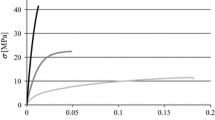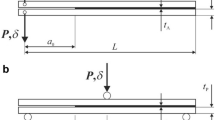Abstract
This work aims to establish a finite element model to simulate the behavior in cracking failure of a shear test of a single lap joint. The interest of having a satisfactory finite element model is to be able to use it to simulate the cases that have not been the subject of experimental tests. A cohesive zone model (CZM) was used to model the propagation of cracks in bonded joints, using a bilinear traction–separation law implemented in the finite element code Abaqus. The cohesive zone is represented by a row of cohesive elements where the progression of the crack will take place. The parameters of the cohesive law of an adhesive “Adekit A140” were determined by fracture tests, performed on DCB and ENF tests. A damage initiation criterion and a mixed-mode failure criterion are used, respectively, to initiate and perform damage to the interfaces. Two numerical models of single lap joint were tested. In the first model (CZMi), the cohesive zone is represented by a row of cohesive elements placed along a single interface (adhesive–substrate) and the second interface of the model being left intact. In the second model (CZMii), the cohesive elements are placed along the two interfaces of between adhesive and substrate. In this case, the cohesive zone comprises two rows of cohesive elements. Experimental shear tests were performed on single lap joints bonded with Adekit A140 adhesive to determine the force–displacement curve. The numerical model using a single row of cohesive elements has a force–displacement curve shifted backward of the experimental force–displacement curve. It shows a greater initial rigidity and less resistance to crack propagation in the joints. The force–displacement curve of the numerical model using two rows of cohesive elements coincides with the experimental force–displacement curve. The numerical force–displacement curve shows good initial stiffness and good resistance to crack propagation in joints. These latest numerical results (two rows of cohesive elements) are in good agreement with the experimental results and allow us to validate the numerical model applied to shear tests of bonded joints.















Similar content being viewed by others
References
Adams RD, Peppiatt NA (1974) Stress analysis of adhesive-bonded lap joint. J Strain Anal 9:185–196
Karachalios EF, Adams RD, daSilva LFM (2013) Single lap joints loaded in tension with high strength steel adherends. Int J Adhes Adhes 43:81–95
Essersi O, Tarfaoui M, Boyd S, Shenoi RA, Meraghni F (2011) Experimental study of dynamic behaviour of aluminum/aluminum and composite/composite double lap joints. Appl Mech Mater 62:155–163
Tarfaoui M (2011) Prediction of the strength of the adhesively bonded joints by the finite elements method. Appl Mech Mater 62:125–134
Adams R, Atkins R, Harris J, Kinloch A (1986) Stress analysis and failure properties of carbon-fibre reinforced plastic/steel double lap-joint. J Adhes 20:29–30
Seong MS, Kim TH, Nguyen KH, Kweon JH, Choi JH (2008) A parametric study on the failure of bonded single-lap joints of carbon composite and aluminum. Compos Struct 86:135–145
Tsai M, Morton J, Matthhews FL (1995) Experimental and numerical studies of a laminated composite single-lap adhesive joint. J Compos Mater 29(9):1254–1275
Tsai M (1995) The effect of a spew fillet on adhesive stress distributions in laminated composite single-lap joints. Compos Struct 32:123–131
Apalak Z, Apalak M, Genc M (2006) Progressive damage modeling of an adhesively bonded unidirectional composite single-lap joint in tension at the mesoscale level. J Thermoplast Compos Mater 19:671–702
Da Silva LFM, Campilho RDSG (2011) Advances in numerical modelling of adhesive joints. Springer, Heidelberg
Feraren P, Jensen HM (2004) Cohesive zone modelling of interface fracture near flaws in adhesive joints. Eng Fract Mech 71:2125–2142
Hamitouche L, Tarfaoui M, Vautrin A (2008) An interface debonding law subject to viscous regularization for avoiding instability: application to the delamination problems. Eng Fract Mech 75(10):3084–3100
Crocombe A, Hua Y, Loh W, Wahab M, Ashcroft I (2006) Predicting the residual strength for environmentally degraded adhesive lap joints. Int J Adhes Adhes 26:325–336
Borg RL, Simonsson K (2004) Simulating DCB, ENF and MMB experiments using shell elements and a cohesive zone model. Compos Sci Technol 64(2):269–278
Valoroso N, Sessa S, Lepore M, Cricrì G (2013) Identification of mode-I cohesive parameters for bonded interfaces based on DCB test. Eng Fract Mech 104:56–79
Alfredsson KS (2004) On the instantaneous energy release rate of the end-notch flexure adhesive joint specimen. Int J Solids Struct 41:4787–4807
Leffler K, Alfredsson KS, Stigh U (2007) Shear behaviour of adhesive layers. Int J Solids Struct 44:520–545
Hashemi S, Kinloch AJ, Williams JG (1990) The analysis of interlaminar fracture in uniaxial fibre–polymer composites. Proc R Soc Lond A Math Phys Sci 427(1872):173–199
Blackman B, Dear JP, Kinloch AJ, Osiyemi S (1991) The calculation of adhesive fracture energies from double-cantilever beam test specimens. J Mater Sci Lett 10:253–256. https://doi.org/10.1007/BF00735649
deMoura MFSF, Gonc-alves JPM, Magalhaes AG (2012) A straightforward method to obtain the cohesive laws of bonded joints under mode I loading. Int J Adhes Adhes 39:54–59
Berry JP (1960) Some kinetic considerations of the Griffith criterion for fracture II: equations of motion at constant deformation. J Mech Phys Solids 8(3):207–216
Berry JP (1963) Determination of fracture surface energies by the cleavage technique. J Appl Phys 34:62–68
ABAQUS/Standard (2014) User’s manual, version 6.14.1. HKS Inc., Dallas
Camanho PP, Davila CG (2002) Mixed-mode decohesion finite elements for the simulation of delamination in composite materials. National Aeronautics and Space Administration, NASA/TM-2002-211737
Campilho RDSG, de Moura MFSF, Ramantani DA, Morais JJL, Domingues JJMS (2009) Buckling behaviour of carbon–epoxy adhesively-bonded scarf repairs. J Adhes Sci Technol 23:1493–1513
Author information
Authors and Affiliations
Corresponding author
Additional information
Technical Editor: Paulo de Tarso Rocha de Mendonça.
Rights and permissions
About this article
Cite this article
Ezzine, M.C., Amiri, A. & Tarfaoui, M. Experimental and numerical investigation of the fracture behavior of adhesive shear tests single lap joints. J Braz. Soc. Mech. Sci. Eng. 40, 382 (2018). https://doi.org/10.1007/s40430-018-1303-5
Received:
Accepted:
Published:
DOI: https://doi.org/10.1007/s40430-018-1303-5




